Sermon copyright (c) 2022 Dan Harper. Delivered to First Parish in Cohasset. The sermon text may contain typographical errors. The sermon as preached included a significant amount of improvisation.
Read Part One (covering 1721-1845)
The photographs, all of ministers who served at least ten years, are from the First Parish archives.
Reading
This morning’s reading is a short humorous poem by Roscoe Trueblood, minister of First Parish from 1945 to 1968:
Congregational Polity
“The minister should lead,” she said,
This she chose to say
Thinking if and when he led
That he would go her way.
But later, when they differed wide,
On points she would not lose,
“The minister should wait,” she cried,
“And let the people choose.”
Sermon
Our congregation was formally organized on December 13, 1721, so we are in our three hundredth birthday year. This is one of a series or occasional sermons I’m preaching this year on the history of our congregation. This morning’s topic is the relationships between the congregation and its ministers from 1835 to the present day.
In 1835, after long-time minister Jacob Flint retired, our congregation called Harrison Gray Otis Phipps to be its next minister. He came to Cohasset directly from Harvard Divinity School, and served for six years until he took ill and died at age 30. Phipps was remembered for his kindness and his good relationships with children. (1)
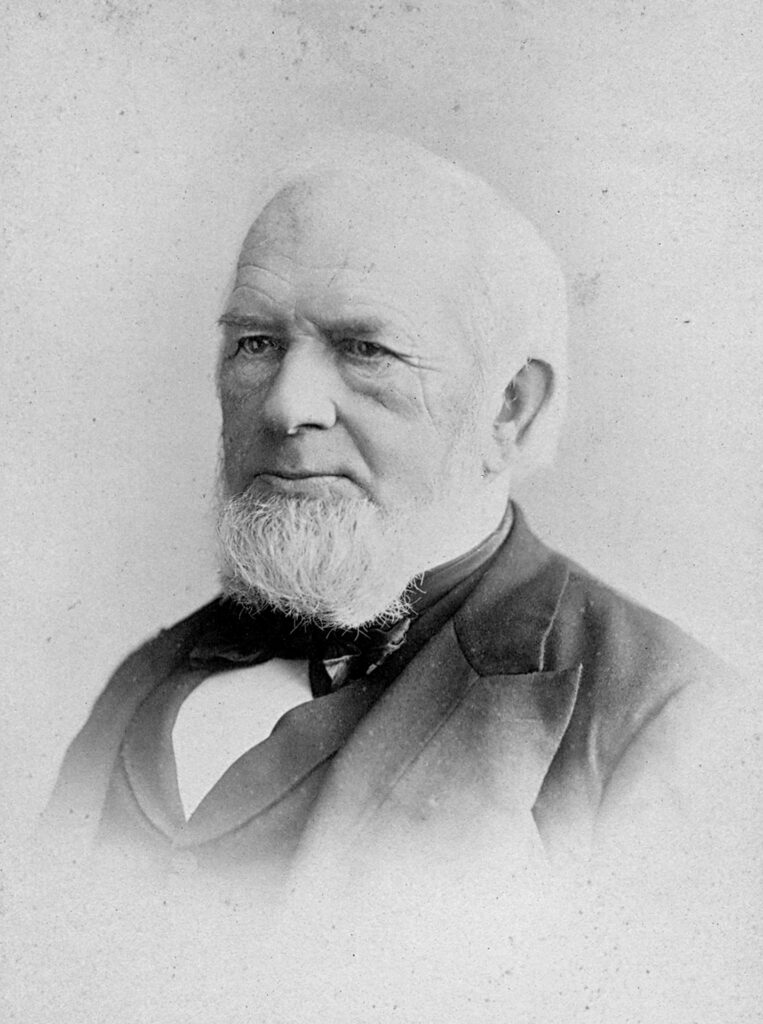
Next the congregation called Joseph Osgood, who began his ministry in 1842 at age twenty-six. He continued as the minister here for fifty-six years, until his death in 1898. This was the longest ministry we’ve ever had, or are ever likely to have. Osgood became intimately involved with the people in this congregation. He presided at nearly one thousand funerals. He officiated at nearly 500 weddings, in some cases performing weddings for two or three generations of the same family. During the first years of his ministry, there was no Catholic priest in town, so Osgood was also called upon to assist with funerals and baptisms among the growing Catholic population in town. (2)
Part of the reason First Parish called Osgood was because of his prior experience as a school teacher. As has been true of many Unitarian congregation, First Parish believed in public education, and they wanted a minister who could help them in that mission. In addition to serving as minister, Osgood devoted significant amounts of time to the Cohasset schools. He served on the Cohasset school committee for thirty years. He helped establish the first high school in town. He served as the superintendent of schools for twelve years; this was a duty of which he later said, “I felt that I had hardly strength to perform or bear.” (3) He served for fifty years on the Board of Trustees of Derby Academy in Hingham. Osgood’s enduring legacy in Cohasset is his work in the schools, and there is still an elementary school in town named after him.
Osgood was able to devote so much time to education, and to people of other religions, because First Parish was not as large as we might think. In the Norfolk County Manual and Yearbook for 1876, First Parish is reported as having just 50 members, with 68 children and teens in the Sunday school. (4) At this time, women were not allowed to vote on parish affairs, so if we include women there were probably about 100 members, roughly the same number of members we have today. Given the size of the congregation and the record of his activities, I’d guess that Osgood spent forty hours a week on his own congregation, and another forty hours a week on community activities. He later wrote that kept his health from breaking under the strain of overwork by working in his garden. (5) He also depended upon his wife, Ellen Sewall, to keep him fed and clothed and to raise their children.
Twenty-five years into his ministry, Osgood wrote: “I have, time and again, felt so dissatisfied with my own work and with my own ministry, that I was ready to lay down the burden and relieve you of my presence; but your forbearance, your consideration, your willingness to overlook all my mistakes and blunders, and to take the will for the deed when I have said and done things which I should not perhaps have deliberately said and sone, have tended very much to preserve this connection.” (6) In spite of his extraordinary accomplishments, Osgood acknowledged his mistakes and remained modest about his own abilities. The congregation for its part was flexible in its expectations, and supported Osgood when he needed support. The relationship between congregation and minister was founded on mutual respect and trust .
Late in life, Osgood began to slow down. First Parish historian Gilbert Tower wrote, “In 1895 [First Parish] was in a weak condition. In his old age, Dr. Osgood had been unable put much life into it.” The congregation hired a young minister named William Roswell Cole to serve as assistant to Osgood. Cole arrived in 1896, and when Osgood died two years later, Cole became the sole minister. Gilbert Tower continues, “Mr. Cole succeeded in starting new projects and fresh ideas so that good health, at least, if not prosperity, was restored to the Parish.” (7)
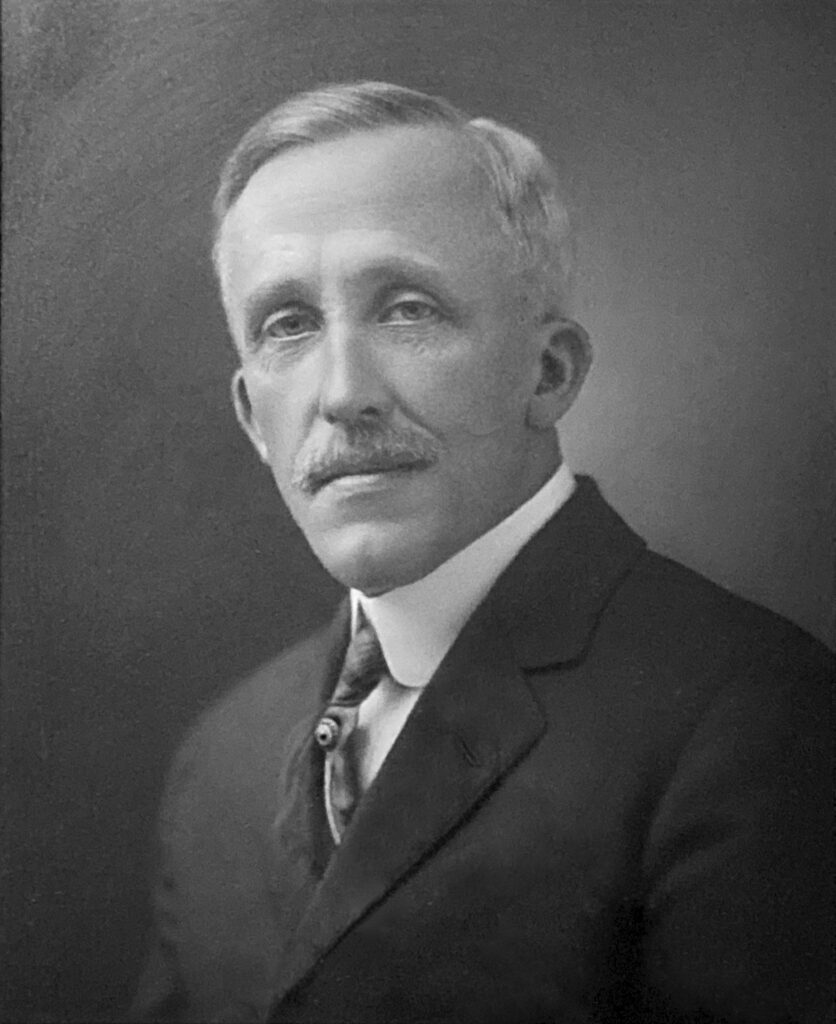
It is tempting to to agree with Gilbert Tower that William Cole was the one who revitalized the congregation. But I think the truth is more complicated than that. First, the Panic of 1893, a serious economic depression that lasted from 1893 to 1897, caused many Unitarian congregations to struggle. No doubt Cole deserves some credit for reviving First Parish, but the improved economic situation after 1897 also deserves credit. Second, Gilbert Tower credits Cole with starting lots of new programs. But in the period from 1890 to the First World War, most Unitarian congregations were adding new programs: local branches of the Women’s Alliance, the Laymen’s League, the Young People’s Religious Union, and so on. This new programmatic approach, a major change in the life of Unitarian congregations, was a widespread social trend, not the innovation of one minister.
Cole’s leadership style was a good match for the congregation. In Gilbert Tower’s words, Cole was a “quiet, unassuming man, friendly and easy in manner with everyone.” The minister’s unassuming leadership style, probably similar to Osgood’s leadership style, allowed Cole to work smoothly with strong lay leaders.
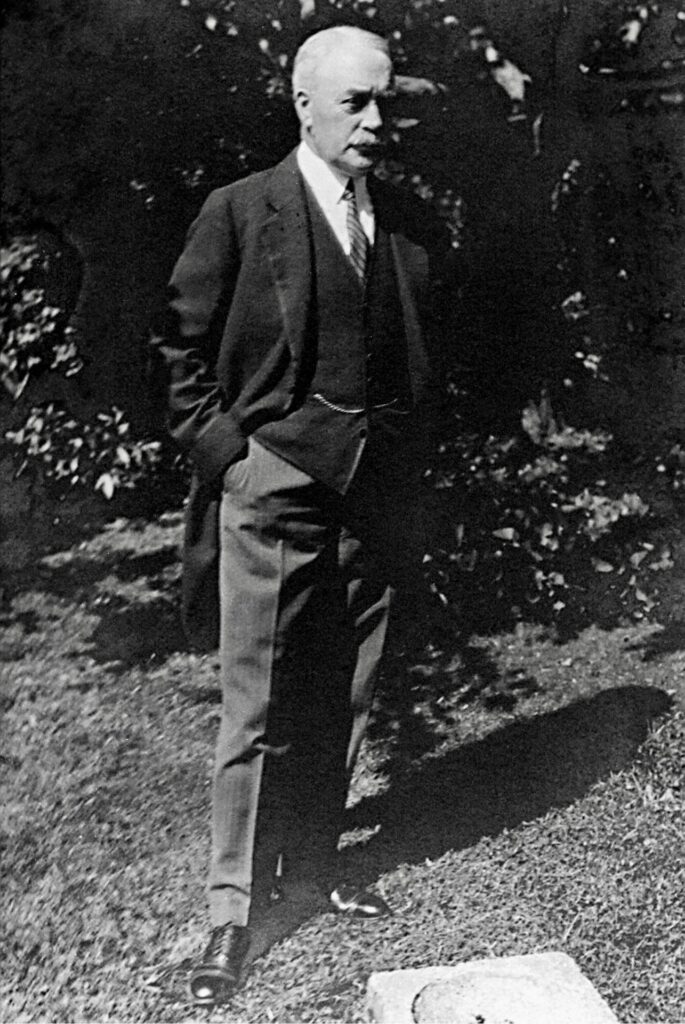
Cole died very suddenly of a coronary embolism on August 21, 1919, at age 54. The congregation called a young minister named George Archibald Mark, who resigned after two years because “First Parish was not active enough for him.” (8) The congregation then called Frederic John Gauld, who served here from 1922 to 1937. First Parish historian Gilbert Tower accused Gauld of being lackluster minister: “Mr. Gauld was a wonderful man and he was very much loved. However he did not accomplish much in building up the parish membership which would have been a real index of success.” (9) But Tower’s assessment of Gauld is unfair. Most of Gauld’s ministry took place during the Great Depression. Perhaps one third of all Unitarian churches closed their doors during the Depression, including many churches in small towns like Cohasset. It’s not fair to blame Gauld for the effects of widespread social forces. Instead, we should credit Gauld and the lay leaders for managing to keep First Parish alive during the Depression.
Gauld retired in 1938, and was followed by Harry C. Meserve, a talented young minister. After four years, Meserve moved on to a larger, better-paying congregation. He was followed by Walter Pedersen, who within a year needed to take a part-time job at the Hingham shipyards to make ends meet. The congregation did not approve of this, and Pedersen resigned. Then the congregation called Roscoe Trueblood, who came to Cohasset in 1945. He was well-liked, but left after four years for a better-paying position in Seattle.
That made three ministers in eight years who left First Parish because of low pay. It turns out that Frederic Gauld’s wife had an independent income, so the congregation was able to get away with paying a small salary during the Depression. But the ministers who followed Gauld were neither willing nor able to accept low pay. Inadequate compensation had an adverse effect on the relationship between minister and congregation.
After Roscoe Trueblood left, First Parish called Gaston Marcel Carrier, a talented young minister from Montreal. When Carrier asked for a substantial raise in salary in his second year, the congregation refused. The congregation wanted Roscoe Trueblood to return, and took advantage of this request for a decent salary to get rid of Carrier. I imagine there was also prejudice against a French Canadian, a common bias in New England through the twentieth century. Carrier left First Parish and went on to a brilliant career as minister in Burlington, Vermont.
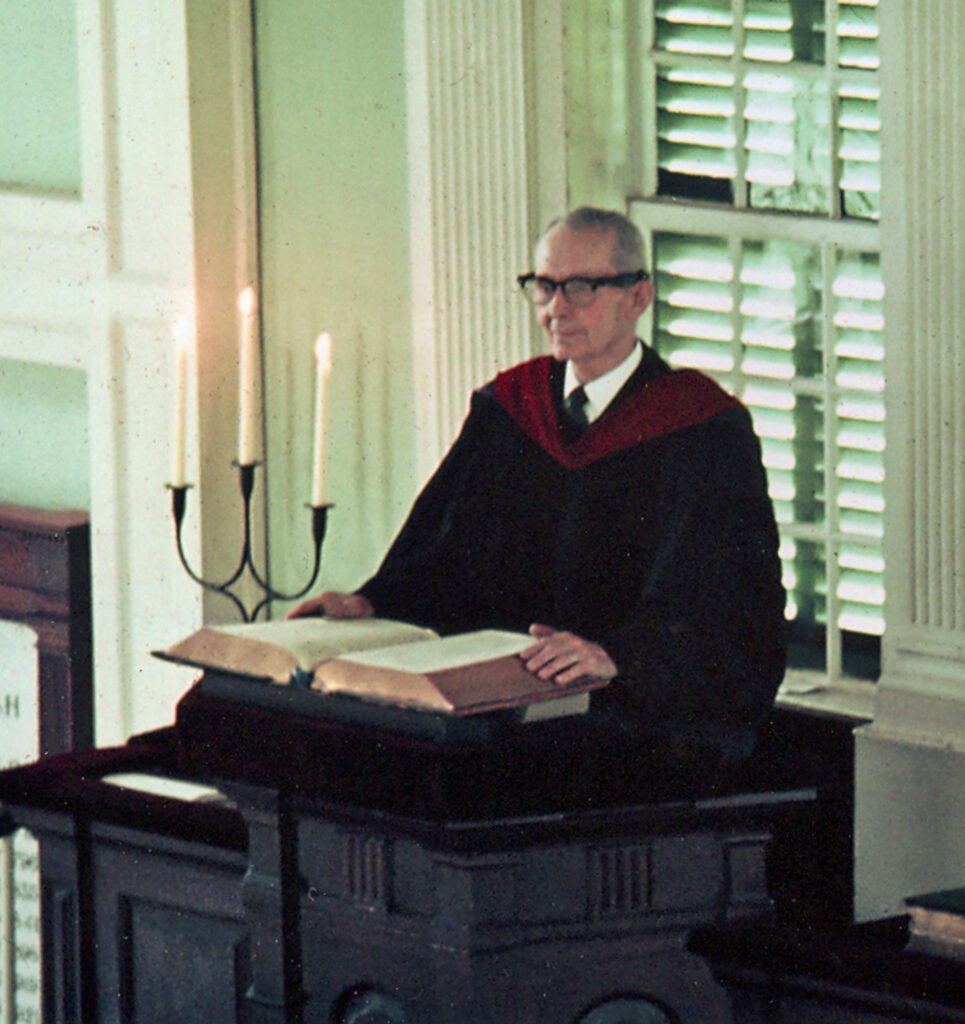
After Carrier’s departure, a handful of big donors pledged gave money to increase the minister’s salary sufficiently to lure Roscoe Trueblood back to Cohasset in 1951. Together, Trueblood and the congregation were able to reap the benefits of post-war demographics. The 1950s was the decade of church-going. It was also the decade of the Baby Boom. Unitarian churches across the United States grew substantially during this time, and First Parish was no exception. While neither the congregation nor Roscoe Trueblood can take credit for the demographic trends that led to growth, both minister and congregation made First Parish a healthy, happy, and welcoming place.
By all accounts, Roscoe Trueblood was quite a person: a good speaker, a good leader, and a good human being. The congregation was a good place to be during this era: friendly, welcoming to children, full of activity. (11) First Parish reached its highest membership level ever in 1969, the year Trueblood retired — 360 members. (10)
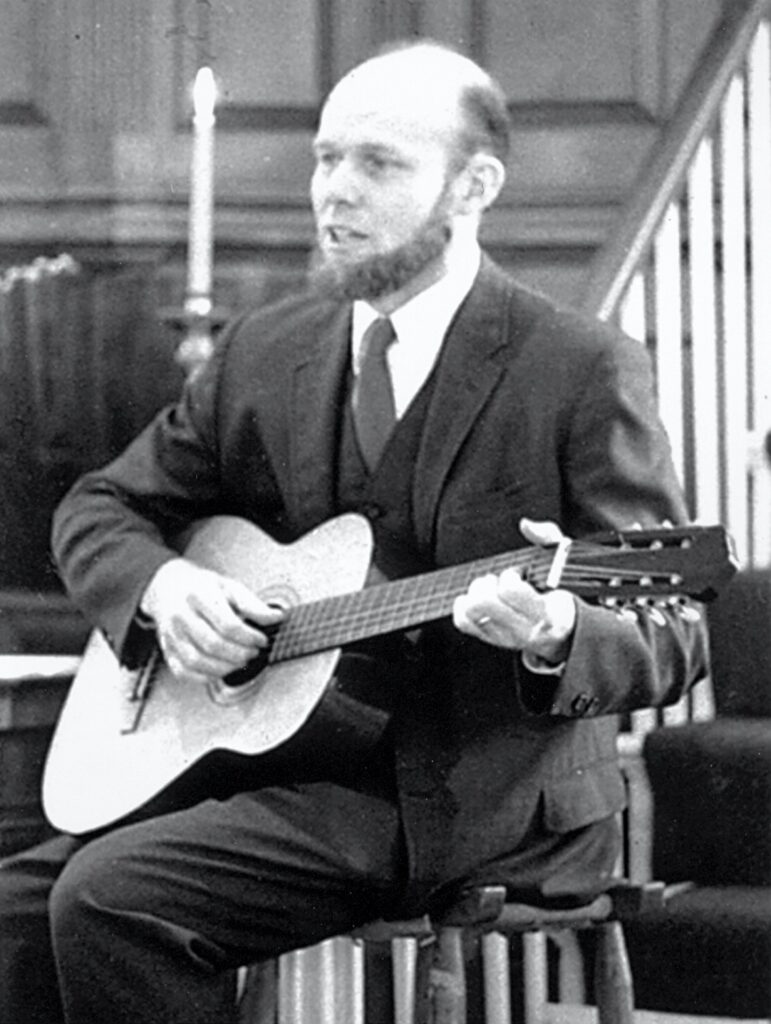
After Roscoe Trueblood’s retirement in 1968, the congregation called Ed Atkinson. Atkinson joined First Parish at a time when people stopped going to church, and congregations across the country began to shrink in size. Some Unitarian Universalist congregations lost three quarters of their members in the 1970s. But not First Parish: there was a decline in membership, but it was slow and gradual. Part of the credit for our success at navigating the troubled times of the 1970s must go to Ed Atkinson. He introduced some big changes. He climbed down out of the high pulpit, and began preaching from the floor. He led an effort to make this building accessible to wheelchairs. He connected with the younger generation by playing his guitar in services. During his tenure, we first began lighting a flaming chalice during Sunday services.
The congregation didn’t always agree with Atkinson’s innovations, but the relationships between congregation and minister remained one of mutual trust and respect. So his sudden death of a heart attack at age 60, on July 24, 1995, was a huge blow to the congregation. (12)
Ed Atkinson was followed by two talented interim ministers, Chuck Gaines and Jenny Rankin. This was the first time First Parish had had interim ministers. Interim ministry emerged as a specialty in the 1970s, to help congregations come to terms with the ending of one ministry, and prepare for a new minister to arrive. Jenny Rankin was the very first woman to serve as minister here, and she helped the congregation to believe that a woman could succeed as a minister here.
In 1997, First Parish called one of the most talented Unitarian Universalist ministers of the 1990s, Elizabeth Tarbox. She was well known in Unitarian Universalist circles for her haunting and compelling writing. But within a year she was diagnosed with cancer, decided not to seek treatment, and died in 1999, aged 55. This was a second huge blow to our congregation, following close upon the death of Ed Atkinson. (13)
During this troubled time, the congregation found a new minister, Jennifer Justice. A charismatic and colorful figure, Jennifer Justice had a background in theatre. Her ministry was not a success, and the congregation dismissed her within two years. First Parish was wise to dismiss her so quickly, but her unethical conduct was yet another blow to our congregation. A few years later, she was forced to resign from ministerial fellowship in the face of a denominational investigation into ethical violations relating to finances. (14)
After two years of interim ministry, the congregation called Jan Carlson-Bull, who served here from 2004 to 2010. Jan and First Parish had six reasonably productive years together. Of particular importance, Jan introduced the Circle Ministry program here, which continues to this day. But eventually tension arose between between minister and congregation. This should be no surprise. Think about what this congregation experienced in the ten years before Jan arrived: Ed Atkinson died suddenly; Elizabeth Tarbox died suddenly; Jennifer Justice had to be dismissed suddenly. Events like these strain the relationship of congregation and minister. It is to the credit of both Jan and First Parish that her ministry continued for six productive years. Jan left in 2010, and went on to a long and successful ministry in Connecticut. (15)
After a two year interim ministry with Anita Farber-Robertson, our congregation called Jill Cowie, a new minister just out of theological school. In many ways, Jill was just what this congregation needed: relatively young, with school-age children, dynamic. However, while Jill related well to some people in the congregation, there were others who did not relate well to her. This kind of divisiveness in a congregation is actually a fairly common pattern in congregations who have had unethical ministers in the past. It also appears that Jill had a different vision for her ministry than some in the congregation. She resigned in 2016, and went on to the Unitarian Universalist church in Harvard, Massachusetts. Recently she decided to leave ministry to become a social worker. (16)
In the twenty-one years from 1995 to 2016, First Parish was served by eleven ministers, two of whom died suddenly and one of whom had to be dismissed. Yet in spite of that run of bad luck, the congregation remained surprisingly healthy; for which I give credit to talented lay leaders who held kept things going in spite of frequent ministerial turnover.
Bob McKetchnie arrived as minister in 2016. Bob’s skills and personality proved to be a good match for the congregation, and the congregation started to bounce back. In March of 2020, the congregation was about to begin a major push for new members. Then the COVID pandemic hit. Yet even though the pandemic was another piece of bad luck, because of good relationships between the minister and the congregation, First Parish weathered the pandemic in remarkably good shape.
As we reflect on the relationships between minister and congregation in the past two centuries, this morning’s reading, the poem by Roscoe Trueblood:
“The minister should lead,” she said,
This she chose to say
Thinking if and when he led
That he would go her way.
But later, when they differed wide,
On points she would not lose,
“The minister should wait,” she cried,
“And let the people choose.” (17)
The relationship between minister and congregation requires constant negotiation. We cannot say definitively that the minister should lead, and the congregation follow. Nor can we say definitively that the congregation should lead, and the minister follow. Sometimes the minister is the leader, and sometimes people in the congregation are the leaders. Because this relationship requires constant negotiation, it helps when the minister and individuals in the congregation are — to borrow from Gilbert Tower’s description of William Cole — quiet and unassuming, friendly and easy in manner with everyone.
It also helps if both the minister and the congregation have a shared vision for what they want to do together. When minister and congregation share a vision, then the words of Joseph Osgood apply: there will be forbearance and consideration, there will be a willingness by all concerned to overlook any mistakes and blunders, and “to take the will for the deed” when we have said and done things which we should not perhaps have deliberately said and done. As with any human relationship, a shared vision allows people to live and work together peaceably in spite of our human failings; and a shared vision contributes to strengthening the connection between people so that we may together strive towards goodness and truth.
Notes
General information is taken from the following histories:
Cole, William R. “One Hundred Fifty Years of the Old Meeting House in Cohasset, Mass., 1747-1847.” Boston George Ellis, 1897.
Osgood, Joseph. “A Discourse Delivered in Cohasset … on the 25th Anniversary of His Ordination as Pastor.” Boston: Alfred Mudge & Son, 1884.
Tower, Gilbert. Unpublished manuscript, 1956.
(1) E. Q. S., “Notice of the Late Rev. H. G. O. Phipps,” Monthly Miscellany of Religion and Letters (Boston: William Crosby and Company, 1842), Feb., 1842, Vol. VI No. 7, p. 92 ff.
(2) “Address of Rev. Joseph Osgood,” Celebration of the Fiftieth Anniversary of the Ordination of Rev. Jospeh Osgood, D.D. (Cohasset: privately printed, 1892).
(3) Joseph Osgood, “Discourse.”
(4) “Twenty-fifth Anniversary of the Wedding of Rev. and Mrs. Joseph Osgood, Cohasset, Thursday, May 20, 1869” (Boston: Alfred Mudge & Son, Printers, 1869), p. 14.
(4) Henry O. Hildreth, compiler, Norfolk County Manual and Year Book for 1876 (Dedham, Mass., 1877), p. 54.
(5) Tower manuscript
(6) Joseph Osgood, “Discourse.”
(7) Tower manuscript, p. 101.
(8) Tower manuscript, p. 118.
(9) Tower manuscript, p. 122.
(10) Membership as recorded in the annual Directories of the Unitarian Universalist Association.
(11) Information about Roscoe Trueblood from First Parish archives, and reminiscences of First Parish members.
(12) Information about Ed Atkinson from First Parish archives, and reminiscences of First Parish members.
(13) Information about Elizabeth Tarbox and interim ministers from First Parish archives, and reminiscences of First Parish members.
(14) Ministerial Fellowship Committee of the Unitarian Universalist Association, “UUA Clergy Removed or Resigned from Fellowship with Completed or Pending Misconduct Investigations,” www.uua.org/uuagovernance/committees/mfc/clergy-misconduct-investigations accessed November 21, 2022.
(15) Information about Jan Carlson-Bull and interim ministers from First Parish archives, and reminiscences of First Parish members.
(16) Information about Jill Cowie from First Parish archives, reminiscences of First Parish members, and other sources.
(17) Roscoe E. Trueblood, I Was Alive and Glad (Cohasset, Mass.: First Parish, 1969).

